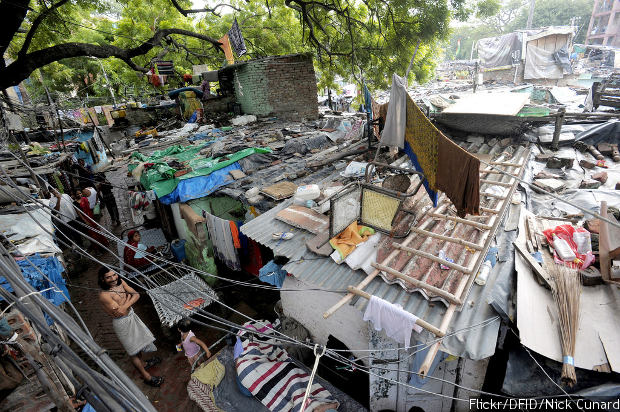5 States Have Half Of India’s Slums
A view of JJ Camp, a large slum in the Kali Bari Marg area of central New Delhi. Five states--Chhattisgarh, Odisha, Jharkhand, Tamil Nadu and Bihar--had 51% of India's slum households, according to a new paper.
The top five states by number of slum households per 100--Chhattisgarh (18), Odisha (17), Jharkhand (14), Tamil Nadu (11) and Bihar (10)--in 2008-09 had 51% of India’s slum households, according to a new paper.
The top five by number of slum households per 100 are the only states/union territories with more than 10% of their population living in slums, said the September 2017 paper by H S Chopra, project director in Rajasthan's rural development department.
Source: Ministry Of Statistics & Programme ImplementationNote: Data not available for other states
In 2008-09, Tamil Nadu had the highest share of India’s slum households at 931,169 or 30%, the only state/union territory with a share in double digits.
Households that lacked a concrete roof, drinking water, a latrine and closed drainage--the criteria laid down by an August 2010 report of the slum census committee--in the 2008-09 survey data of the National Sample Survey Office, India’s official socio-economic surveyor, were counted as slums.
A slum is defined as “a compact settlement of at least 20 households with slum-like conditions as given in the above criteria”, according to the paper.
Overall, 3.15 million--about 28% less than the Census 2011 figure of 4.4 million--or 5% of India’s households were in slums in 2008-09.
The only communities with more than 10% of their population living in slums were scheduled castes and scheduled tribes, deprived communities identified in India’s constitution for government support.
| India’s Slums By Community | |||
|---|---|---|---|
| Caste | Slum households (In million) | Total households (In million) | Slum households (As % of total households) |
| Scheduled Tribes | 0.25 | 2.18 | 11.47 |
| Scheduled Castes | 1.02 | 9.59 | 10.64 |
| Other Backward Classes | 1.36 | 25.1 | 5.42 |
| Other Castes | 0.52 | 29.5 | 1.76 |
Source: Ministry Of Statistics & Programme Implementation
In urban India, 60% slums are on government land with 40% owned by urban local bodies, according to the draft National Urban Rental Housing Policy 2015.
The share of slums with a health centre and a primary school within 1 km fell 16 and 3 percentage points, respectively, to 47% and 87% in 2009 from 63% and 90% in 1993, according to the housing and urban poverty alleviation ministry’s 2015 statistical compendium on slums.
In Mumbai--home to the world’s third largest slum by population, Dharavi--90% of deaths result from respiratory diseases, according to a survey by International Institute of Population Sciences, Mumbai, the Indian Express reported on August 7, 2015. Apart from Dharavi, slums in Mumbai’s suburbs too were growing to become at least as big as Dharavi, the Times Of India reported on July 6, 2011. Despite having India’s largest slums, only 3.7% of Maharashtra’s 9.8 million households were in slums, and only one in 100 households in the state was in a slum in 2008-09.
Slum dwellers often sell homes that the government relocates them to because these end up being far from their workplaces, according to Saudamini Das at Delhi University’s Institute Of Economic Growth, City Labs reported on June 9, 2017.
- Develop housing on slum land: draft National Urban Rental Housing Policy 2015
- Govt provide streetlight and sewage facility to slum households: “Do neighbourhood facilities matter for slum housing? Evidence from Indian slum clusters”, March 15, 2016, by Saudamini Das and Arup Mitra (Institute Of Economic Growth, New Delhi) and Rajnish Kumar (Jawaharlal Nehru University, Delhi)
- Give unconditional no-eviction guarantee: Mukta Naik, Centre For Policy Research, to the Indian Express on May 12, 2017
Correction: An earlier version of the story used the words 'slum' and 'slum household' interchangeably at a few places. We have now corrected it. An earlier version of this story erroneously said 2008-09 was the latest year for which data on slum households were available. We regret the errors.
(Vivek is an analyst with IndiaSpend.)
We welcome feedback. Please write to respond@indiaspend.org. We reserve the right to edit responses for language and grammar.
__________________________________________________________________
“Liked this story? Indiaspend.org is a non-profit, and we depend on readers like you to drive our public-interest journalism efforts. Donate Rs 500; Rs 1,000, Rs 2,000.”



